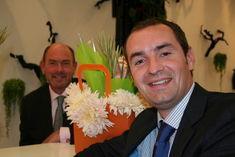
The FCoH’s latest UK TV ad campaign has switched its emphasis to the shop floor.
The new set of TV spots run for 10 seconds each under the strapline “So Simple, So Try It” and are a step forward from the previous “Why Not Buy Your Own?” campaign, says Thompson. “Our previous TV campaign was very successful - people liked it,” he says. “But what we realised was that the above the line TV message was not getting down to the shop floor, where the consumer’s purchasing decision is most influenced.”
Post-ad consumer research showed the FCoH that 75 per cent of households purchase flowers, which illustrates the potential for increased penetration. The previous advert had acted as a spark of interest, but consumers were still unsure what they could do with flowers if they bought them.
“We have taken a broader view now,” Thompson says of the new approach, “and focused on simplicity to fit in with the prevalent sales channels for the products.” Translation of the overall message into a shop floor sales driver was key in the design of the ad. “It couldn’t be just one message and it had to contain messages that could be used in different ways,” he says.
Each ad gives three easy steps to creating your own floral display, and attempts to unravel the mystery surrounding flower arrangement in the home. “The way we are talking to consumers is far more open,” says Thompson. “People have a set idea of flower arranging as being a bit dusty, but we’ve tried to change that through use of a Jamie Oliver style of talking.”
Flowers for the sorted generation. The target audience is ABC1 female, aged 35-54, as a result of joined-up demographic thinking. “Flowers are about the moment of life you’re in, not necessarily your age,” says Thompson. “Between 25 and 34, people might live with their mum and dad or on their own and they are not likely to buy flowers as a matter of course. We still want to tell people at that stage of life what they can do with flowers, but we are trying to encourage them to buy flowers more readily and in more volume when they reach the next stage.
“Our main emphasis now though is a call to action. When people start buying flowers, they typically buy more than 20 bunches a year, so there is huge potential.
“We are also trying to get the industry behind us, which is another call to action. If we sell more flowers and plants, we sell more food, more vases etc, so any campaign is of benefit to Oasis, Pokon, the sundries guys - the whole chain. Their active support and participation makes the campaign even stronger.”
Intra-industry buy-in to a successful campaign could eventually lead to all manner of opportunities in terms of new product preferences, sales avenues, new partnerships and more. The promotional effort has evolved to reflect the changes in the industry, but could also act as a catalyst for change in its own right.
“There has been a very positive reaction to the campaign in the UK,” says the FCoH’s UK chief Jo Read. “People seem to really relate to the message. Now it’s up to the industry to take advantage. Some florists were worried that we are taking an integral part their job away from them by encouraging people to design their own, but it is up to them to inspire and upsell once customers come into their shops.
“This about energising the consumer. We don’t want them to just go to the shop and buy flowers, we want them to become more involved, to lose their inhibitions and jump the barriers. Working with a florist is like [working with] a recipe. But what we need people to realise is that it doesn’t always need to be a Gary Rhodes recipe - it can be designed to suit you.”



